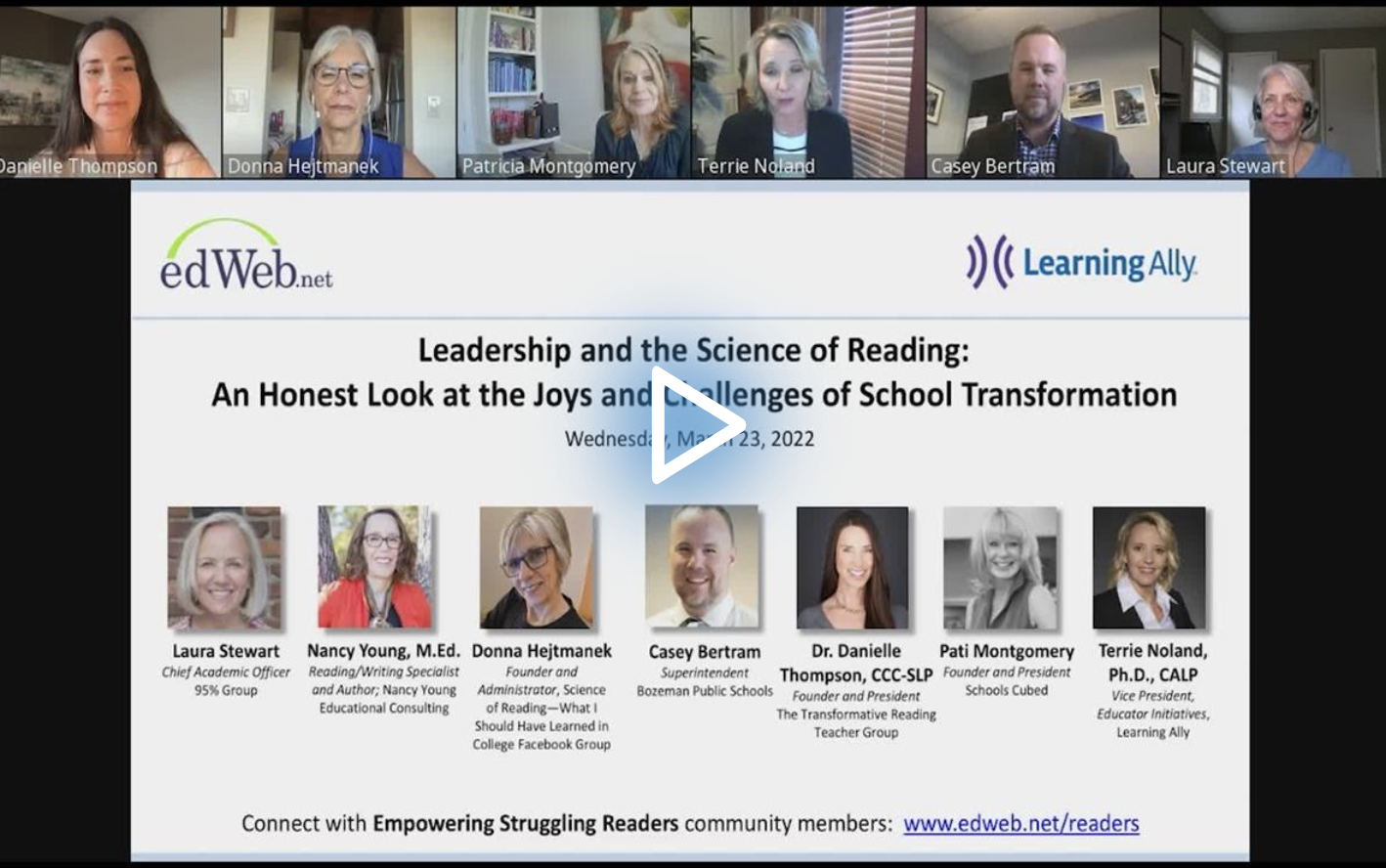Transforming Reading Instruction to Include the Science of Reading
Watch the Recording Listen to the Podcast
Changing the reading instruction provided by a school or district is a complex, multi-step process that can take years to accomplish, but as one presenter noted during the edLeader Panel, “Leadership and the Science of Reading: An Honest Look at the Joys and Challenges of School Transformation,” it can transform students’ lives as well as significantly increase their academic achievement.
A panel of educators and experts who have firsthand experience with the process of transforming reading instruction discussed this transformation process as well as the lessons they’ve learned.
The panelists noted the importance of establishing structures and systems that support the transformation process, and engaging classroom teachers, specialists, and administrators in developing a comprehensive and cohesive approach.
First Steps and Long-Term Goals
Dr. Danielle Thompson, President and Founder of the Transformative Reading Teacher Group, recommends beginning with an honest discussion of what the student data shows and how the results can be improved. This may result in a “bumpy ride” at the start, but it’s a crucial part of the process for establishing short-term and long-term goals. She also suggested that educators be “urgent in the moment and patient in the results,” while celebrating the progress that occurs along the way.
In Bozeman Public Schools (MT), Superintendent Casey Bertram sees the transformation process taking five to ten years and including multiple goals, such as an early literacy goal, individual grade-level goals, and professional learning goals for the district staff. He emphasized the importance of having all the structures and systems working together and based on the science of reading, as well as having the district policies and funding in place to purchase appropriate curriculum materials and provide the professional development needed to use the materials effectively.
Dr. Thompson has found that leadership can take many forms and work on multiple levels, and the transformation process works best when there is a unified movement toward a shared vision, which includes the development of professional relationships, growth as a team, and collective advocacy based on dialogue and collaboration.
Moving Forward
Donna Hejtmanek, Legislative Chair of the International Dyslexia Association’s Wisconsin branch, pointed out the importance of aligning support systems and techniques that contribute to the success of scientifically based reading instruction. Reading intervention programs and Multi-Tiered Systems of Support (MTSS) need to be part of the same cohesive approach and based on assessments that measure what has been learned while also identifying areas where more intensive instruction is needed.
She also recommends optimizing school schedules to develop consistent times for literacy instruction and using the same types of vocabulary development routines across the grades. Hejtmanek sees routines as a source of strength, because “kids thrive on knowing what’s coming.”
Another important aspect of scheduling that Bertram emphasized is providing time for teachers to do diagnostic work, have deeper conversations, and continue with their professional learning, which won’t happen as well or at all if left until late in the day after school is over. He believes these types of processes and schedules should be in place and working well before a curriculum-selection process begins.
Pati Montgomery, Founder and President of Schools Cubed, added that professional learning communities are crucial but can be ineffective, so there needs to be ongoing evaluation of what is being learned and the impact it is having. In a similar way, progress monitoring without over-assessing is crucial for the continued evaluation of student achievement.
Dr. Thompson agreed about the importance of progress monitoring, which should include diagnostic tools that show what skills students actually know and whether those skills have been fully mastered. Educators also need to be able to differentiate between a persistently poor responder to Tier I instruction and someone who just needs a limited amount of targeted teaching.
At the Secondary Level
For students in middle and high school who did not receive scientifically based reading instruction and are now reading below grade level, Bertram believes there needs to be a combined process of retooling structures while building teacher knowledge. Another important aspect is keeping in mind that older students “need to be treated with dignity” while receiving the additional reading instruction they need.
Knowing that middle and high school are content focused, Montgomery believes that all teachers need to participate in the literacy-development process and can do so through content-vocabulary routines that break words down into syllables, prefixes, and suffixes, so students understand the meaning-based elements of words, while also hearing read-alouds that continue to improve decoding and fluency. Selecting a highly effective Tier III intervention is also crucial.
As Montgomery noted, meeting content-area standards while increasing secondary students’ reading levels can be accomplished and occur at the same time that primary students are receiving scientifically based reading instruction, which should lessen the need for secondary intervention in the future.
Learn more about this edWeb broadcast, “Leadership and the Science of Reading: An Honest Look at the Joys and Challenges of School Transformation,” sponsored by Learning Ally.
Watch the Recording Listen to the Podcast
Join the Community
Empowering Struggling Readers is a free professional learning community that provides educators, administrators, special educators, curriculum leaders, and librarians a place to collaborate on how to turn struggling readers into thriving students.

Blog post by Robert Low based on this edLeader Panel





Comments are closed.